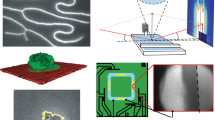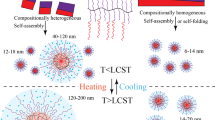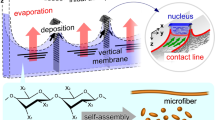Abstract
In aqueous systems, the hydrophobic effect drives the self-assembly of amphiphiles into a broad range of micellar, rod-like, bicontinuous and liquid-crystalline complex fluids. Many of these are relevant to biological matter or technological applications. However, amphiphilic self-assembly is not limited to aqueous systems. Replacement of water with supercritical carbon dioxide, for example, results in complex fluids that combine the properties of gases and liquids1. Along this vein, we explore the self-assembly of surfactants in anhydrous sugars. Our study reveals that anhydrous powders of sugars and surfactants suspended in oil spontaneously form molten glasses with nanometre-size domains of sugar and liquid oil without mixing. The low cost, water solubility, low toxicity and stabilizing properties of glassy sugars make them ideal water replacements for many pharmaceutical, food and materials synthesis applications. The optical clarity and solid appearance of these glasses at room temperature belie their inclusion of more than 50% (vol.) oil, which confers liquid-like diffusivity. The unique combination of solid- and liquid-like properties may lead to applications in sensors and optical devices.
This is a preview of subscription content, access via your institution
Access options
Subscribe to this journal
Receive 12 print issues and online access
$259.00 per year
only $21.58 per issue
Buy this article
- Purchase on Springer Link
- Instant access to full article PDF
Prices may be subject to local taxes which are calculated during checkout




Similar content being viewed by others
References
McClain, J. B. et al. Design of nonionic surfactants for supercritical carbon dioxide. Science 274, 2049–2052 (1996).
Kahlweit, M. & Strey, R. Phase-behavior of ternary-systems of the type H2O-oil-nonionic amphiphile (microemulsions). Angew. Chem. Int. Edn 24, 654–668 (1985).
Schubert, K. V. & Kaler, E. W. Nonionic microemulsions. Ber. Bunsenges. Phys. Chem. Chem. Phys. 100, 190–205 (1996).
Strey, R. Phase behavior and interfacial curvature in water-oil-surfactant systems. Curr. Opin. Colloid Interface Sci. 1, 402–410 (1996).
Teubner, M. & Strey, R. Origin of the scattering peak in microemulsions. J. Chem. Phys. 87, 3195–3200 (1987).
Sottmann, T. et al. A small-angle neutron scattering study of nonionic surfactant molecules at the water-oil interface: Area per molecule, microemulsion domain size, and rigidity. J. Chem. Phys. 106, 6483–6491 (1997).
Gompper, G. et al. Measuring bending rigidity and spatial renormalization in bicontinuous microemulsions. Europhys. Lett. 56, 683–689 (2001).
Endo, H. et al. Effect of amphiphilic block copolymers on the structure and phase behavior of oil-water-surfactant mixtures. J. Chem. Phys. 115, 580–600 (2001).
Olsson, U. et al. Change of the structure of microemulsions with the hydrophile lipophile balance of nonionic surfactant as revealed by NMR self-diffusion studies. J. Phys. Chem. 90, 4083–4088 (1986).
Macosko, C. W. Rheology: Principles, Measurement, and Applications (Wiley, New York, 1994).
Van Krevelen, D. W. Properties of Polymers (Elsevier, Amsterdam, 1994).
Arndt, M. et al. Length scale of cooperativity in the dynamic glass transition. Phys. Rev. Lett. 79, 2077–2080 (1997).
Jackson, C. L. & McKenna, G. B. The melting behavior of organic materials confined in porous solids. J. Chem. Phys. 93, 9002–9011 (1990).
Cheng, F. et al. Preparation of a mesoporous silicon boron nitride via a non-aqueous sol-gel route. Chem. Commun. 242–243 (2003).
Beckett, M. A. et al. Formation of borosilicate glasses from silicon alkoxides and metaborate esters in dry non-aqueous solvents. J. Sol-Gel Sci. Technol. 39, 95–101 (2006).
Niederberger, M. et al. Non-aqueous routes to crystalline metal oxide nanoparticles: Formation mechanisms and applications. Prog. Solid State Chem. 33, 59–70 (2005).
Acknowledgements
This work was made possible through grants from Givaudan Flavors Corporation, the National Science Foundation (CTS#0548364) and small-angle neutron-diffractometer beam time at Argonne National Laboratory supported by the Department of Energy (W-31-109-ENG-38).
Author information
Authors and Affiliations
Corresponding author
Ethics declarations
Competing interests
The authors declare no competing financial interests.
Supplementary information
Supplementary Information
Supplementary figures 1 and 2 (PDF 125 kb)
Rights and permissions
About this article
Cite this article
Dave, H., Gao, F., Lee, JH. et al. Self-assembly in sugar–oil complex glasses. Nature Mater 6, 287–290 (2007). https://doi.org/10.1038/nmat1864
Received:
Accepted:
Published:
Issue Date:
DOI: https://doi.org/10.1038/nmat1864
This article is cited by
-
Just add sugar for carbohydrate induced self-assembly of curcumin
Nature Communications (2019)
-
Dynamically arrested micelles in a supercooled sugar urea melt
Communications Chemistry (2018)



